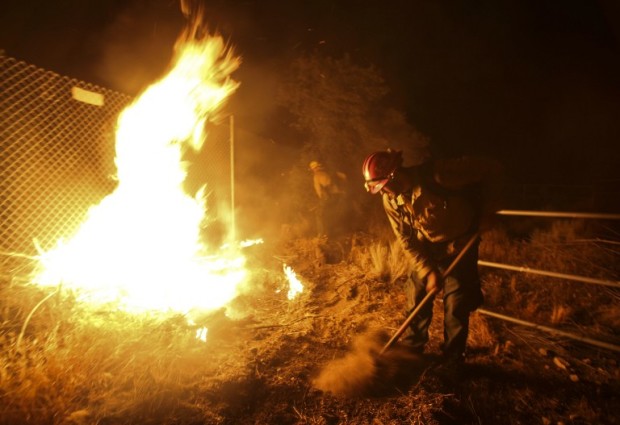
A small firenado swirls as a firefighter battles the Blue Cut wildfire burning near Cajon Pass, north of San Bernardino, California on August 16, 2016. The rapidly spreading fire east of Los Angeles forced the evacuation of more than 82,000 people as the governor of California declared a state of emergency. Despite the efforts of 1,250 firefighters with more on the way, none of the inferno was contained, state firefighting agency Cal Fire spokeswoman Lynne Tolmachoff told AFP. The wildfire poses “imminent threat to public safety, rail traffic and structures,” according to the website, which said 82,640 people fell under an evacuation warning. AFP PHOTO
PHELAN, United States — An inferno scorching swathes of southern California threatened the homes of more than 82,000 people Wednesday, sending flaming “firenadoes” tearing across the brush and prompting a state of emergency.
More than 1,300 firefighters were battling the giant blaze, with more on the way, but they were unable to contain the blaze as of early Wednesday.
Dramatic local TV news footage captured from the front line of the wildfire in the town of Phelan showed tornado-like flaming vortexes — known as “firenadoes” — sent spinning into the air by the unusual ferocity of the blaze.
READ: California town decimated by wildfire; 175 homes burn
“We have very, very dry brush, thick fuel, it helps move it along very quickly,” Lynne Tolmachoff, spokeswoman for the state firefighting agency Cal Fire, told AFP.
“It is very dangerous to the public and also to the firefighters.”
Governor Jerry Brown declared a state of emergency for San Bernardino County, just 60 miles (100 kilometers) east of Los Angeles, where the so-called Bluecut Fire was quickly growing, its cause still unclear.
The inferno began around 10:30 am (1730 GMT) Tuesday and has already burned through 30,000 acres (more than 12,000 hectares), according to the multi-agency Inciweb information site.
More than 34,500 homes were threatened and 82,640 people were under evacuation warnings.
“There is imminent threat to public safety, rail traffic and structures in the Cajon Pass, Lytle Creek, Wrightwood, Oak Hills and surrounding areas,” Inciweb said.
From the highway between Wrightwood and Lytle Creek, a thick cloud of smoke could be seen blanketing the entire valley.
‘Not worth your life’
A dozen fire trucks awaited orders to evacuate Paso Lane, located between several hills that were being devoured by flames, columns of smoke billowing into the sky.
“The whole community is being evacuated,” said local firefighter Mike Anderson, who had been battling the blaze with his team for more than 24 straight hours.
“The fire is moving very fast straight through Highway 138, it is still growing.”
Chon Bribiescas of the US Forest Services said later that the evacuation area was being expanded, with the wind picking up and the temperature soaring to 100 degrees Fahrenheit (38 Celsius).
“The fire is consuming 100 acres in a few minutes instead of 100 per hour,” she told AFP, adding that many residents had decided against the best advice to remain in their homes.
“In California, we cannot force people from their homes, but that means we have firefighters that have to come back to the mandatory evacuation zones instead of fighting the fire.
“I try to tell people that there is nothing in your home that is worth your life.”
At a gas station in the outpost of Pinon Hills, 10 miles northwest of the fire, Jeannine Yglesia was buying ice with her 24-year-old son.
“I have 17 to 18 people staying at my house now, friends and their families that have had to evacuate from Wrightwood,” she said.
Gail Nieto, a 65-year-old woman buying groceries, was forced to flee Wrightwood on Tuesday night.
“It’s the fourth time in 30 years, but it’s the fastest-growing fire I have ever seen,” she said, trembling.
Perfect conditions
Among equipment already deployed were 152 fire engines, eight air tankers plus two Very Large Air Tankers (VLATs), and eight helicopters, including night-flying helicopters.
The inferno has claimed one high-profile victim so far: the Summit Inn, an old-fashioned diner on the world-famous Route 66 that counted celebrities Elvis Presley and Clint Eastwood among its clientele.
There was little left other than the sign hanging above the smoldering ashes.
Two firefighters were slightly injured after they were surrounded by flames. They were treated at a hospital and released, and were back fighting the blaze, Inciweb said.
Several area roads were closed, along with the Mountain High ski resort in Wrightwood, which hosts hiking and other outdoor activities in warmer months.
It was rare to have so many people evacuated, Tolmachoff said.
California is in its fifth year of a record drought and parts of the state are sizzling in a heat wave with temperatures topping 104 degrees Fahrenheit.
Strong seasonal gusts known as the Santa Ana winds complete the perfect conditions for wildfires.
Thousands of firefighters are committed to several other major fires across California, including one 100 miles north of San Francisco that has charred 4,000 acres, destroying 175 buildings.
In central California’s wine region, the Chimney fire has burned 7,300 acres near the city of San Luis Obispo, destroying 40 buildings, while 76,000 acres have been scorched in the scenic coastal area of Big Sur.